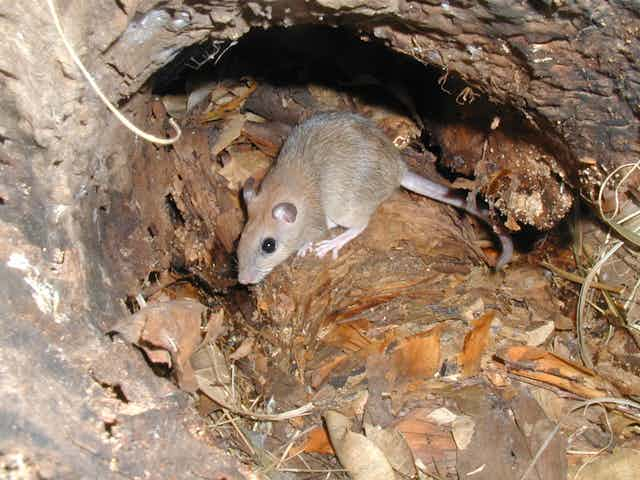Mammals are disappearing in Australia’s Top End, and we’re not really sure why.
This is particularly concerning as northern Australia has a human population density of one person per ten square kilometres. It also has extensive and largely natural vegetation cover. The red fox, responsible for much of the mammal decline further south, is absent from the area. Currently we think the declines are a combination of changing fire frequencies, grazing, and cat predation.
The current massive declines echo previous declines in the arid zone.
The Carpentarian Rock-rat (Zyzomys palatalis) is one of these declining mammals. It is one of five species of rock rats, and is only known from five gorges and escarpments on Wollogorang pastoral station near the Northern Territory-Queensland border. It was only described in 1989, with the first specimens collected in 1986.
Together with the Central Rock-rat, it is listed as critically endangered on the IUCN Red List.
It is physically very similar to the other species of rock-rat, and differs mainly in skull characteristics. Its habitat consists of rainforest and vine thickets in rocky sandstone gorges and escarpments.

Status
With a highly restricted distribution, the Carpentarian Rock-rat population was estimated to be fewer than 2,000 in 2006. This includes an estimated population of 696 at Moonlight Gorge and 450 at Banyon Gorge. Modelling of rock-rat home range sizes and habitat availability indicates there may be 782 home ranges for the Carpentarian Rock-rat in the area.
Threats
The threats to the Carpentarian Rock-rat are common to other species of small mammal in the Top End: changed fire regimes, and the effects of introduced animals and plants.
Population modelling indicates that the population is highly sensitive to the frequency of hot, late dry-season fires, and these fires could lead to the rat’s extinction within 100 years.
Trampling and grazing of sensitive vegetation by feral herbivores may also cause a decline in the habitat and abundance of Carpentarian Rock-rats.
There is currently no information on cat predation on the Carpentarian Rock-rat, but cats are suspected to cause the decline of other small mammals in the Top-End.

Strategy
Due to this species being poorly known, and an almost complete lack of past data of distribution and abundance, targeted research in required to understand the population dynamics of this species. It is even uncertain whether the population has actually declined.
To prevent intense hot fires of the late dry season, it has been recommended to conduct regular, controlled fuel-reduction burns early in the dry season. These are more similar to the burning practises of Traditional Owners, which may be better for the rats.
Establishment of new populations of the species, based on captive breeding, may increase the long-term survival of the species. There were two trial translocation programs to suitable habitat in nearby Limmen National Park, but neither were successful.
We don’t know how many cats are in the area, but adoption of suitable control practises, such as targeted baiting, may be a good idea.
Conclusion
The Carpentarian Rock-rat is a species with a highly restricted distribution, leading to its critically endangered status. Targeted research is required to address the declines of many small mammal species in Australia’s Top End. We need to understand fire and feral species management better.
A greater understanding and implementation of appropriate fire management strategies is needed, as well as effective management of feral species.

Images supplied by Damian Stanioch of the Territory Wildlife Park, which has previously assisted in the Carpentarian Rock-rat recovery plan and captive breeding.
The Conversation is running a series on Australian endangered species. See it here.

